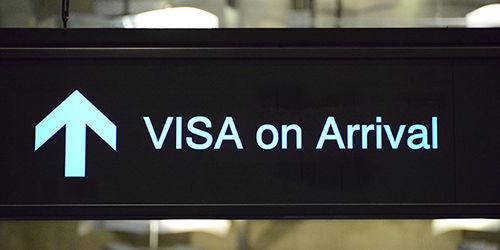
Indians can seldom make last minute plans because travelling on an Indian passport means having to apply for a visa for most countries beforehand. However, when I saw the list of countries where I could obtain a visa on arrival I was ecstatic! To apply for a visa on arrival meant that I could travel at a short notice and plan in half the amount of time that I usually take.
While the charm of obtaining a visa on arrival is very appealing, there is a lot of information that is not readily available on the web. Without this information, travelling to a foreign land can sometimes turn out to be a nightmare.
In this post, I attempt to provide the information that would take reams of search pages to find, and also provide a first-hand account of some problems I faced when I opted for the visa on arrival option during my trails.
At the outset, please note that this post is not exhaustive. I have not travelled to all the countries that provide the visa on arrival facility, so my knowledge is limited. The experience I draw from the visa on arrival system is solely based on the countries I travelled to / information obtained from friends who have travelled to such countries, and therefore, this problem may not be encountered by you during your travels to such countries / any other country that offers this option. I endeavour to update the information on this page as and when I get more information on this topic.
When to opt for a visa on arrival
• When you plan to enter a country only once and not multiple times; and
• Good option for last minute travel plans.
Advantages of visa on arrival
• No waiting time for visa applications; and
• Good option for last-minute travel plans.
Disadvantages of visa on arrival
• Not a good option for multiple entries into a country. Visa on arrival is usually valid only for single entry;
• Sometimes, applying for the visa beforehand can be lesser in cost than a visa on arrival;
• Some countries have pre-requisites before availing of the visa on arrival option, so you need to be careful and check for information on the web about the pre-conditions of visa on arrival;
• Need to have all your documents in order before travelling;
• Longer wait time at the airport for immigration, and longer lines;
• Lack of information about change in laws on visas on arrival; and
• Not a good option for transit when you take two different flights of two different airlines.
• Example 1: Thailand
When I was travelling from New Delhi (India) to Phnom Penh (Cambodia), I was travelling via Bangkok (Thailand). I had opted for Spice Jet (New Delhi-Bangkok) and Air Asia (Bangkok-Phnom Penh) due to the significantly lesser cost than travelling by a single airline. My flight from New Delhi was to land at Suvarnabhumi airport in Bangkok and my flight to Phnom Penh was to take off from Don Muaeng airport in Bangkok. Since I had planned this trip last minute, I had to opt for visa on arrival at Bangkok. These are the problems I faced:
o Since I was in transit and had to switch airports, I had to take the visa on arrival instead of taking a connecting flight from the same airport without needing one;
o When I landed, the application noted that as of the beginning of the month, the fees for visa on arrival had doubled. There was very sparse information on this on the web. That completely threw off my financial planning for the trip, and I had to incur a huge cost in the process;
o Visa on arrival is usually a single entry visa, so I had to take the visa twice: once on my onward journey and once on my return journey. Therefore, my costs doubled.
o On the other hand, the visa on arrival option worked out great for me when I was in Cambodia, as I needed to enter the country only once.
• Example 2: Hong Kong
A friend of mine was planning to travel to Hong Kong on a holiday. Since January 2017, Hong Kong has introduced a pre-requisite for obtaining a visa on arrival. Indian passport holders have to now apply for, and successfully complete pre-registration online before they can visit or transit in Hong Kong (except in cases where you are in transit and don’t leave the airport premises). Pre-registration has to be done online, and the immigration authority has the right to accept / reject your application. In case of rejection, you have to apply for an entry visa with the immigration department of Hong Kong, which is a very lengthy process. Sometimes, these applications are rejected for unclear reasons, or passengers are unaware of this requirement, which can be difficult to deal with. This issue can lead to a significant monetary loss too, particularly if your accommodation arrangements and flight tickets have been paid for.
Final verdict
While there are some significant advantages of applying for visas on arrival, sometimes, the paucity of information on the web can lead to some grave implications on your travel plans, particularly monetarily. In my experience, applying for a visa on arrival and banking on that option can be risky. If you are on a budget, are unclear on the information on the visa on arrival and don’t want glitches in your trip, then it is best to apply for an e-visa or a visa from the embassy / consulate before embarking on your trip. On the other hand, if you are planning a last minute trip and are sure of your research on the visa on arrival requirements, then this is a great option for Indian travellers. In the end, it must be a carefully considered and weighed option that is best suited to your priorities.

